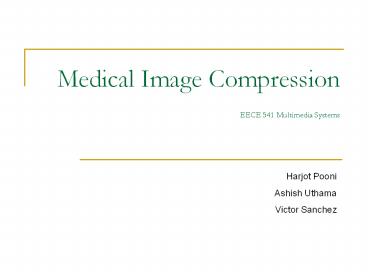Medical Image CompressionEECE 541 Multimedia Systems - PowerPoint PPT Presentation
Title:
Medical Image CompressionEECE 541 Multimedia Systems
Description:
Department of Electrical Engineering and ... Tele-radiology applications. Real time Tele-consultation. PACS (Picture archiving and communication systems) ... – PowerPoint PPT presentation
Number of Views:147
Avg rating:3.0/5.0
Title: Medical Image CompressionEECE 541 Multimedia Systems
1
Medical Image Compression EECE 541 Multimedia
Systems
Harjot Pooni Ashish Uthama Victor Sanchez
2
What are medical images ?
- Some examples
- MRI / FMRI (Function Magnetic Resonance)
3
Medical Images
- Dynamic 3D Ultrasound
- PET (Positron emission Tomography)
- CT (computerized Tomograhpy)
4
Why compress medical images?
- Growing need for storage
- Efficient data transmission
- Telemedicine
- Tele-radiology applications
- Real time Tele-consultation.
- PACS (Picture archiving and communication systems)
5
Challenges unique to medical images.
- Compression Algorithms
- Lossy / Lossless
- Medical Images should always be stored in
lossless format. - Erroneous Diagnostics and its legal implications.
6
Techniques used
- Compression techniques may be classified into
- Lossy
- Lossless
- Moreover, compression algorithms may be applied
in the spatial domain or frequency domain
7
JPEG 2000 and JPEG-LS
- High compression efficiency
- Lossless color transformations
- Progressive by resolution and quality
- Multiple component images
- ROI coding (static and dynamic)
- Error resilience capabilities
- Object oriented functionalities (coding,
information, embedding)
8
Drawbacks of JPEG 2000 and JPEG-LS
- Only looks for redundancy in the frame.
- Does not exploit 3D and 4D redundancy
- 3D Redundancy
9
4D Redundancy
- Exploits temporal redundancy
10
Ordering the data to exploit redundancies
- Transform the problem domain Convert 4D data to
a sequence of 2D data - Volume
- Time
11
3D-JPEG 2000
- Part 10 JP3D
- Part 10 is still at the Working Draft stage. It
is concerned with the coding of three-dimensional
data, the extension of JPEG 2000 from planar to
volumetric images - -http//www.jpeg.org/jpeg2000/j2kpart10.html
- Some commercial vendors have already come out
with 3D extensions of JPEG 2000
http//www.aware.com/products/compression/J2K3D.ht
ml - Provides guidelines for the use of JPEG 2000 for
3D data
12
3D-JPEG 2000 The basic approach
- Wavelet transforms
13
3D-JPEG 2000 The basic approach
- Reorder the 4D data by time or volume
- For each set, apply a 1D wavelet transform along
the z axis - Apply JPEG 2000 on each transformed slice
14
Drawbacks
- Does not effectively use the redundancy in the
4th dimension (Temporal redundancy) - Movement of object between two slices would
adversely effect performance - Object motion is significant in medical imaging
- Patient movement
- Organ movement (Heart, Lung)
15
H.264/AVC
- Latest video coding standard ? uses motion
compensation and estimation.
Source www.vcodex.com
16
Why use H.264?
- Better Intra frame compression
- Medical images have comparatively more uniform
areas - Motion estimation and compensation
- Address temporal redundancies
- Multiple frames may be used to predict a single
frame. - Better performance
- Different block sizes for motion estimation
(16x16, 16x8, 8x8) - Better performance!
- Improved entropy encoder
- Better performance!!
17
Approach One H.264-VOL
Apply H.264/AVC on slices arranged as shown
above Results
Compression Technique Compression ratio
JPEG2000 2.551
JPEG-LS 3.061
3D-JPEG 2000(VOL) 3.151
H.264-VOL 3.891
18
Approach Two H.264-TIME
Apply H.264/AVC on slices arranged as shown
above Results
Compression Technique Compression ratio
JPEG2000 2.551
JPEG-LS 3.061
3D-JPEG2000 (Time) 7.371
H.264-TIME 12.381
19
Best compression performance
H.264 applied across time ? H.264-TIME
20
How to improve compression efficiency?
- Two ideas
- Get the difference between consecutive image
slices, then use H.264 - Calculate the residual frames, then use H.264
- Main objective reduce the energy content of each
- image slice.
21
Difference between slices
s coded bit-streams
Slice 1
Slice 2
Difference
22
Residual frames
Volume 1
Volume 2
Volume n
H.264 MC entropy coder (CABAC)
Reference slice
Reference slice
Reference slice
Slice 1
Slice 1
Slice 1
Slice s
Slice s
Slice s
s coded bit-streams
H.264 MC
H.264 MC
H.264 MC
Residual 2
Residual 2
Residual s
Residual s
Original slice
Predicted
Residual
23
Results
Compression Technique Improvement Improvement
Compression Technique H.264 Difference H.264 Residual
3D-JPEG2000 100 100
H.264-TIME 20 27
24
Future improvements
- Contextual encoding ? take into account
characteristics of image
High motion
Low motion
25
Future improvements
- Low motion areas ? lossy
- High motion areas ? lossless
Lossless
Lossy
26
Future improvements
- Encoding using slices (group of macroblocks)
- First slice for high motion areas
- Second slice for low motion areas
- Slices may be encoded at different rates
First slice
Second slice
27
Questions?































